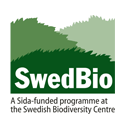Species in the Genus
Species in Kenya, Tanzania & Uganda
Description
Possible Causes of Confusion
Distribution in Kenya, Tanzania & Uganda
Habitats
Nesting
Crops Visited
Other Plants Visited
Economic / Ecological Importance
Threats
Conservation and Management Practices
Legislation (National and International)
References
Editors
Acknowledgements
Contact
Click on images to enlarge
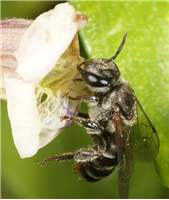
Lipotriches species. © Bernhard Jacobi

Lipotriches species. © Bernhard Jacobi
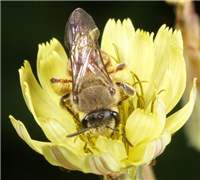
Lipotriches testacea. © Bernhard Jacobi
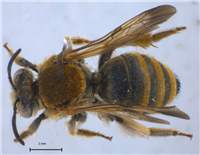
Lipotriches orientalis (female) - pinned specimen. Photo: Connal Eardley
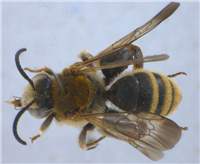
Lipotriches orientalis (male) - pinned specimen. Photo: Connal Eardley
Summary
Honey bees are not the only bee species that are significant for human wellbeing. Lipotriches bees are a group of native bee species that do not produce honey but are important pollinators of crops and wild plants. Females have a sting, but they are not aggressive and will only sting if handled. Lipotriches bees are solid looking medium sized bees (7-12 mm in length) usually with a striped abdomen and metallic appearance. They look like Nomia bees but Lipotriches bees do not have pale integument bands on abdomen , their bands are pale hairs. They live independently of others (i.e. they are solitary) and build their nests in the ground. This fact sheet provides information about these bees to encourage farmers to understand and protect them to help ensure that their crops are effectively pollinated.
From a conservation and agricultural standpoint it is not necessary to recognise all the different bee genera. However, it is important to know that there is a large bee biodiversity. Different bee genera pollinate different plant species, although there is some overlap that acts as a buffer as bee populations wax and wane. For healthy ecosystems, including agro-ecosystems both diversity and abundance in the bee fauna is important.
Scientific Classification
Kingdom: Animalia
Phylum: Arthropoda
Class: Insecta
Order: Hymenoptera
Family: Halictidae
Subfamily: Nomiinae
Genus: Lipotriches Gerstaecker, 1858
Species in the Genus
Bee species in the genus Lipotriches are found throughout the Eastern Hemisphere though they are not present in
Species in Kenya, Tanzania & Uganda
About fifty species have been recorded in different habitats in
Description
Lipotriches bees are not well known by local people (including farmers) in
Possible Causes of Confusion
Some insect species look like large Lipotriches bees: These are other Halictidae (Nomia, and Pseudapis bees). They look like Nomia bees but Lipotriches bees do not have pale hairless bands on abdomen that are found on Nomia bees . These are easy to confuse with other species frequently encountered on flowering plants during peak blooming periods. In such circumstances expert assistance might be needed.
Distribution in Kenya, Tanzania & Uganda
Lipotriches bees are found in most districts/regions of
Habitats
Lipotriches bees can be found in various habitats (land-uses) in East Africa such as grasslands, natural forests, wetlands, marshlands, open habitats, protected areas, farmlands, rangelands, woodlands, woodlots (forest plantations) and riparian areas.
Nesting
Lipotriches bees are solitary ground nesting bees (Michener 2007). Lipotriches bees are commonly found nesting in termite mounds in shaded and dry places in different semi-natural habitats.
Crops Visited
Lipotriches bee species in
Other Plants Visited
In
Economic / Ecological Importance
Little information exists on the usefulness of these bees to the lives of the people in
Threats
In
Conservation and Management Practices
There are now concerted research efforts in the region to develop best practices for conservation and management of bees to enhance crop production. Theoretically, bee conservation and management is inexpensive and adopted activities can also improve the aesthetic value of the landscape. Such practices involve setting land aside (e.g. a 1-metre strip) in the farmland to host all year round food resources for the bees, as well as safer sites for nesting, mating, resting and refuge from natural enemies. During flowering, farmers should manage pesticide usage carefully to avoid poisoning flower-visiting bees. Farmers should also minimise pesticide drift from the field to adjacent areas. Laws governing registration and use of plant protection products indirectly play a major role in the protection of pollinators. Trampling by people and livestock and tilling should be managed to conserve the nesting sites of soil-nesting species. KARI (the Kenya Agricultural Research Institute) is developing protocols for mass rearing of different species of solitary bees. Any successful results from this research will be freely communicated to the public. In addition, KARI is collaborating with other stakeholders to ensure in situ conservation and management of bees for pollination purposes. Much of the work of conserving native bees will be underpinned by raising public awareness of the importance of these species.
Legislation (National and International)
There is not yet any legislation in
References
1. Eardley CD, Gikungu MW and Schwarz MP (2009) Bee conservation in Sub-Saharan Africa and
2. Eardley CD and Urban R (2010) Catalogue of Afrotropical bees (Hymenoptera: Apoidea: Apiformes). Zootaxa, 2455: 1–548.
3. Michener CD (2007) The Bees of the world, the John Hopkins University Press,
Editors
Théodore Munyuli, Busitema University - Uganda; Muo Kasina, Kenya Agricultural Research Institute (KARI) - Kenya; Juma Lossini, Tropical Pesticides Research Institute (TPRI) – Tanzania; John Mauremootoo, BioNET-INTERNATIONAL Secretariat – UK; Connal Eardley, Plant Protection Research Institute (PPRI) – South Africa.
Acknowledgements
We recognise the support from the Kenya Agricultural Research Institute (KARI), Tropical Pesticide Research Institute (TPRI) –
Contact
BioNET-EAFRINET regional coordinator: [email protected]





